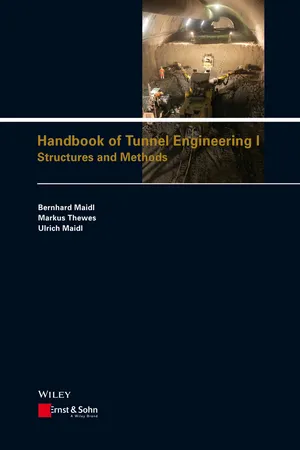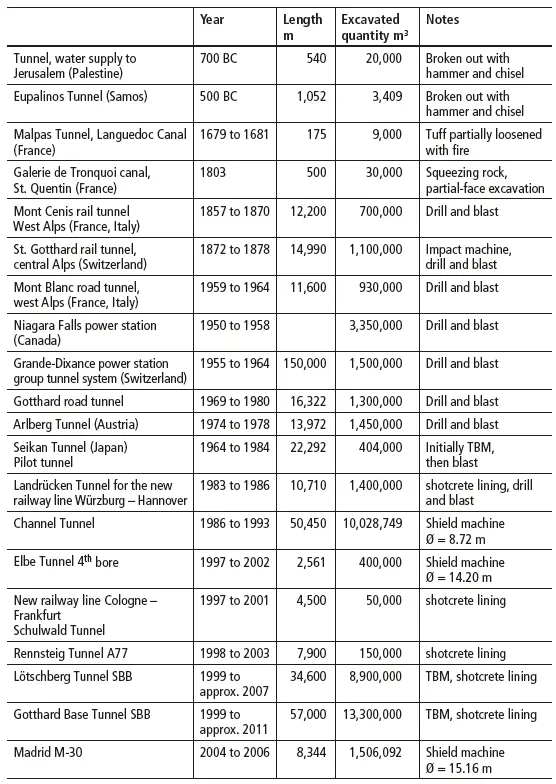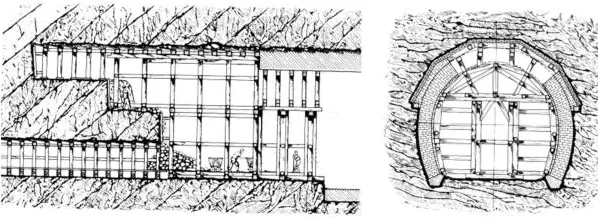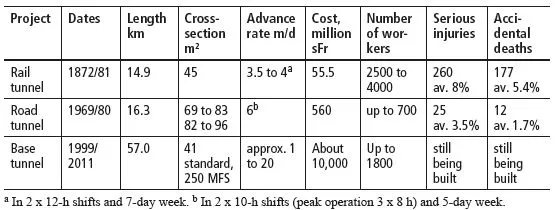![]()
1
Introduction
1.1 General
Tunnelling is one of the most interesting, but also the most difficult engineering disciplines. It unites theory and practice into its own construction art. For the weighting of the many influential factors, practice is sometimes more important, and at other times theory, according to ones own state of knowledge. Tunnel engineering is normally performed by civil engineers. Everyone, however, should be aware that knowledge about structural analysis and concrete engineering alone is not sufficient. Geology, geomechanics, mechanical engineering and particularly construction process technology are equally important.
1.2 Historical development
Tunnels and caverns already existed in nature before mankind started to create them artificially to meet vital interests.
Tunnel engineering in the 20th century could also make use of existing specialised knowledge from mining. One of the founding fathers was Georg Agricola, whose 1556 work De Re Metallica, Libri XII covered mining and metallurgy.
Drill and blast
The building of significant tunnels in the Alps had already led to a first heyday of tunnelling before 1900, which explains why the railway engineer Franz Ržiha, mining superintendent of the duchy of Braunschweig, considered tunnel engineering as a separate discipline from mining in his 1867 textbook of tunnelling. This heyday continued to the start of the 20th century, after which there were only a few spectacular tunnel projects (Table 1-1) until 1960. The building of the Mont Blanc Tunnel was the start of a new phase in Europe, which continued with the construction of the Tauern Autobahn Tunnels, the Arlberg Tunnel and the new Gotthard Tunnel. The construction of more than a hundred tunnels by the German Railways (Deutsche Bundesbahn, later: Deutsche Bahn AG) continued the development. A new phase opened with the Seikan Tunnel, the Channel Tunnel and the base tunnels through the Alps.
The extent of the enormous development in tunnelling enabled by currently available support materials and machinery is illustrated in Fig. 1-1 and Fig. 1-2 for conventional tunnelling. The introduction of shotcrete as a means of support introduced a new phase of development, which made much greater use of machinery. Only years later did mechanisation take off again, permitting simultaneous working at the face and removal of the excavated material. The development of tunnel boring machines was even more impressive, and this is dealt with in detail in Chapter 6.
Table 1-1 Historical overview of some notable tunnels
Figure 1-1 Construction of the Semmering Tunnel in 1848 using the old Austrian method [302]
Table 1-2 The data for the various Gotthard Tunnels
Figure 1-2 Construction of the Westtangente Tunnel, Bochum in 1982 with shotcrete [343]
Comparison of the data from the various Gotthard Tunnels in Table 1-2 shows that extremely short construction times were already possible many years ago, but the number of accidents has been greatly reduced by the modernisation of tunnelling technology.
Large underground structures have also been built for hydropower stations outside Europe, for example at Tarbela in Pakistan and Cabora Bassa in Mozambique. Many projects are still urgently needed, even if these have not yet been implemented due to financing problems. Underground and urban rapid transit lines, but also road tunnels will have to be extended to solve environmental and traffic problems in the cities. New developments in tunnel boring machines and in microtunnelling will assist the requirement in cities for environmentally friendly construction of extensive transport works, water supply and drainage, district heating, post and other utilities.
In German coal mining, development headings and drifts have amounted to annual totals of more about 100 km in rock and 400 km of coal roads in the past. As coal mining in Germany is discontinued, this will no longer be needed, although mining will maintain its significance outside Germany.
Tunnel boring machines
The development history of the first tunnel boring machine (TBM) has featured many tests that failed due to various problems, with the exception of the successful work of the Beaumont Machines in the Channel Tunnel. Sometimes the limitations of the available materials had not been considered, or else the ground to be driven through was simply not suitable for a TBM. Early applications proved successful where the ground offered ideal conditions for a TBM drive.
As early as 1851, the American Charles Wilson developed and built a tunnel boring machine, although he didn’t patent it until 1856. This machine already showed all the features of a modern TBM and can thus be described as the first tunnel boring machine; see also Chapter 3.4.
Shield machines
Tunnel builders learnt long ago to support unstable rock or loose soil with timbering followed by a masonry lining. This was also successful in rock with seepage or joint water, but working below the water table in permeable soil or particularly under open water remained impossible well into the 19th century. The situation changed in 1806, as the ingenious engineer Sir Marc Isambard Brunel in London discovered the principle of the shield machine and later obtained a patent. The purpose of the invention was the building of a link across the Neva in St. Petersburg that could remain open in winter. As this project was not built, the machine was only developed on paper for the patent. Brunel was only able to try out his ideas in practice on the Thames Tunnel in London (see Chapter 3.4 “The Classic Shield Machines”).
1.3 Terms and descriptions
In order to describe and understand underground structures, knowledge of the most important specialist terms and descriptions is essential. As there is not always a generally accepted term from the variety of terms derived from mining, preference has been given to those that have become most widely used and most precisely describe the subject (Table 1-3).
Table 1-3 Categories of underground structures [50, 51]
| Tunnels | Rail tunnels, Underground rail tunnels, road tunnels, canal tunnels | to provide transport routes |
| Small tunnels | Main structures
Unpressurised tunnels, pressure tunnels, siphons Access tunnels | transport of drainage water, drinking water and service water
all-year access to caverns with avalanche protection
supply of fresh air to underground cavities |
| Ventilation tunnels
Auxiliary structures
Grouting tunnels
Pilot tunnels
Viewing tunnels
Adits | access for grouting works investigation of geological conditio... |




